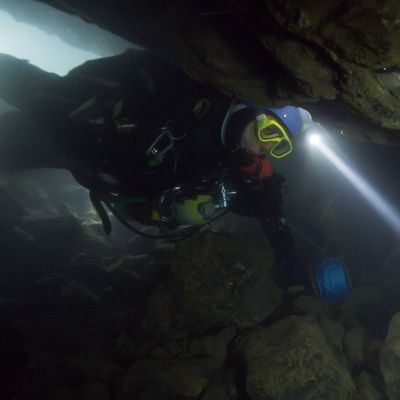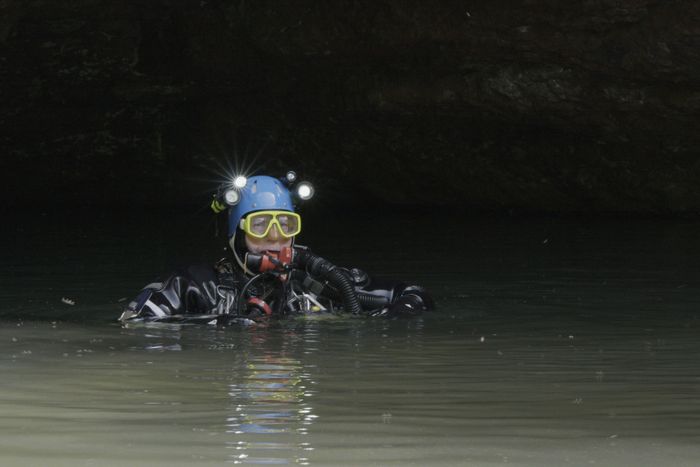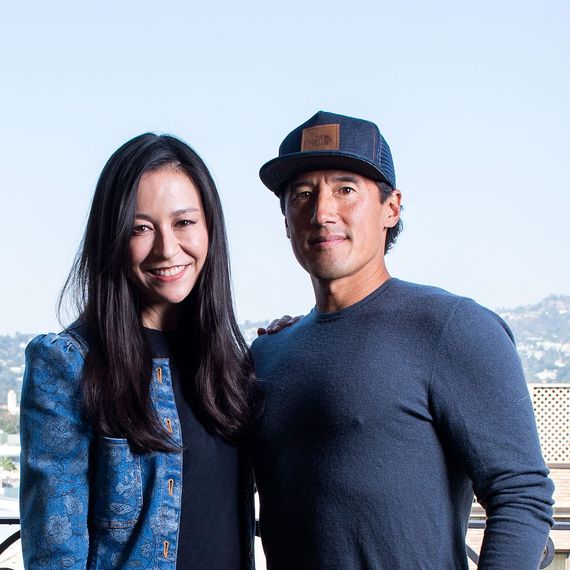
The National Geographic documentary The Rescue pulls off something almost as far-fetched as its subject matter. It turns a story whose outcome is instantly familiar ÔÇö the search-and-rescue mission to recover 12 young soccer players and their coach who became trapped in a flooded labyrinth of caves in northern Thailand in 2018 ÔÇö into a white-knuckle viewing experience filled with unexpected twists, heartrending drama, and suspense.
Directed by the husband-and-wife duo E. Chai Vasarhelyi and Jimmy Chin, The Rescue debuted at the Telluride Film Festival early last month, picked up the PeopleÔÇÖs Choice Documentary award at the Toronto International Film Festival a few days later, and reached theaters last Friday as an Oscars front-runner. But the NatGeo feature is also notable as the first of several high-profile, Western-backed Thai-cave-rescue projects heading down the production pipeline.
NetflixÔÇÖs as-yet untitled limited series will be presented from the perspective of the Wild Boars soccer team and their coach and executive-produced by Crazy Rich Asians director Jon M. Chu. And then thereÔÇÖs Ron HowardÔÇÖs biographical drama Thirteen Lives, filmed in Australia this spring and starring Colin Farrell, Viggo Mortensen, and Joel Edgerton as, respectively, the cave divers John Volanthen, Richard ÔÇ£RickÔÇØ Stanton, and Dr. Richard Harris, a loose collective of U.K. and Australian hobbyists who materialized as if out of nowhere to spearhead the international efforts involving thousands of people that saved the team.
Chin, a professional mountain climber and skier, and Vasarhelyi shared a 2019 Best Documentary Feature Academy Award for the gravity-defying mountain-climbing documentary Free Solo. They spoke to Vulture via Zoom about their efforts to soothe the real-life cave diversÔÇÖ apprehensions about becoming documentary subjects, ultimately persuading them to perform reenactments of their daring rescue in a giant tank inside southwestern EnglandÔÇÖs Pinewood Studios. The directors detailed the immense difficulty of narrowing an enormous story involving dozens of talking heads into a two-hour feature. ÔÇ£We thought that no one ÔÇö like, no one ÔÇö would understand the film,ÔÇØ Vasarhelyi says.
Watching the plight of the Wild Boars unfold night after night on the news, I thought I knew this story. And yet itÔÇÖs a thousand times stranger, scarier and more surprising than I ever expected. So I have a two-part question: You are known for films about climbing ÔÇö how did you gravitate toward this subject? And how much did you know about the Thai cave rescue before you got involved?
E. Chai Vasarhelyi: Like you, we were riveted to the TV. You think back to the summer of 2018, it was the World Cup, it was like the world was falling apart otherwise. And then there was this rescue. We are also the parents of Asian kids, so it was personal. We just chased the story.
There are a lot of feature films that are set to tackle this. Did you need to obtain life rights before shooting yours?
EV: The life-rights situation is very strange for us. Like, you donÔÇÖt really ÔÇ£ownÔÇØ people in nonfiction. ItÔÇÖs not really the ethos. But because of the life-rights situation, because of all the Hollywood movies that are being made, it was very simple. One studio owned the children and their families. Another studio owned the life rights of the divers. WeÔÇÖd been tracking this project, and we knew that National Geographic had the rights. And we asked them if we could direct.
One of the thrills of this film is discovering this subculture of cave divers even exists: this odd little group of people who admit they ÔÇ£donÔÇÖt play well with others.ÔÇØ As documentarians, what was it like to unpack that culture and find out what made them such unlikely heroes?┬á┬á
Jimmy Chin: They are great characters. But we related pretty easily to them because of our understanding of a different type of subculture thatÔÇÖs also very extreme, has high stakes and extraordinary risks, and draws a certain type of person. So that felt in some ways familiar, which gave us some insight into how to get to the heart of their stories.
Also, most of the divers had seen Free Solo, and they related deeply to that film. So we had some credibility.
EV: ItÔÇÖs also symptomatic of our working relationship, where Jimmy is a professional climber and heÔÇÖs coming from the inside. And IÔÇÖm like, ÔÇ£Oh, isnÔÇÖt this fascinating! Why would you ever do that?ÔÇØ
JC: I was like, ÔÇ£I totally get why they did that!ÔÇØ
EV: We hope to make films that are character portraits that allow you to go on this journey and see through someone elseÔÇÖs eyes. With these guys, we were interested in How do you become a person who is able to be your best self and make an absolute moral decision? How do you become that generous? Like, Who are these people who do that?
JC: When you have everything to lose.
The film showcases how this group of loners came together to provide a team infrastructure that, in turn, galvanized thousands of other volunteers, who all pitched in to achieve the impossible. Where was your identification in that?
JC: The part that really drew us in was just, in a time when the world is so divided and polarized, that this was a moment where people from all over the world, from different countries, different cultures, of different religious and political beliefs, came together because of their common humanity. We thought that was an important reminder of what we are capable of and what we hold in common.
Let me ask you a technical question: There are reenactments featuring the actual cave divers. How did you shoot those scenes?
EV: Ideally, we would have shot in Thailand. But there is a pandemic, Rick is turning 60, and it just seemed way too risky for everybody. So we did it in a tank. But I think of it less as reenactments than demonstrations ÔÇö like, the divers teaching us how you actually do this, to experience what they did. Because it was only them and the kids.
JC: Gathering the divers for them to demonstrate served multiple purposes. They showed up in the gear that they used and we were able to see how they prepared, the head space they get into whenever they go cave diving. And being able to film it with them and see how they did it was amazing and important to us because authenticity is super critical for us.
EV: Like, I only could have an inkling of what the weight of the whole situation was like when you see them bind a childÔÇÖs hands behind their back, bind their feet, and submerge the head. The gravity of that! You try as a nonfiction filmmaker to conjure the truth of the situation for audiences. But we didnÔÇÖt understand until we saw them demonstrate it.
On TV, it was presented as this international rescue initiative using top professionals. But here you see itÔÇÖs really these weird guys who cobble together this funky equipment for their own purposes, and suddenly theyÔÇÖre using it under these extraordinary circumstances.
JC: And itÔÇÖs duct-taped together. YouÔÇÖre just like, Oh my God! ItÔÇÖs so old looking! We went to visit their homes. RickÔÇÖs got a kayak in his living room, literally dive equipment everywhere you look. And you know: TheyÔÇÖre lifers. They live and breathe cave diving.
Did any of the divers require extraordinary persuasion to get in the tank?
EV: It was hard to understand that we would do right by them. It took a big leap of faith.
JC: I work on both sides of the lens; sometimes IÔÇÖm in front of it. I expressed to them my concerns, and I think they really bought into this idea of Well, this is going to be the most authentic way for us to show this if we do it right. They want the details to be right because theyÔÇÖre very detail-oriented people.
Most people know the outcome of this story. What was the trick to building suspense into the narrative? Not only suspense but nail-biting, hanging-by-the-edge-of-your-seat suspense?
EV: I mean, we bled. It was like blood on the floor. One, the events transpire over 18 days. The children are only found on the 11th day. And then no one really makes a decision for a long time. And you see the same thing 13 times. And thatÔÇÖs not all the narrative challenges you have. There are way too many people. WhoÔÇÖs speaking now? Why are they speaking? Well, actually, they played a critical role.
JC: Everybody played a critical role!
EV: We always knew there was too much and always felt this pressure to whittle and whittle: ÔÇ£Can we simplify?ÔÇØ It was interesting leaning into the details that ended up in it ÔÇö why people are understanding the film ÔÇö because we thought that no one ÔÇö like, no one ÔÇö would understand the film.
Did you and NatGeo ever discuss turning this into a multipart doc?
EV: In our really dark moments it would come up. ÔÇ£Maybe we could do Shoah. Is this Shoah?ÔÇØ Or, like, OJ: Made in America: ÔÇ£We could do the six hours.ÔÇØ
JC: Our first cut, we were like, Hmmm, thereÔÇÖs 900 characters. There are a lot of parallels from the rescue and the making of this movie.
What was the most surprising thing you discovered while making it?
EV: There was a lot of speculation about how Saman Kunan died. We were really the only people who spoke extensively to the Thai Navy SEALs, the army, and the divers. Because of the work we did to gain access to the Thai Navy SEALs, I spent a lot of time with his widow. And we uncovered how he died, which wasnÔÇÖt publicly known. The SEALs confirmed, and tell the story in the film, of how he was tasked with dragging these five wetsuits ÔÇö
JC: Hugely buoyant. Hard to move through current.
EV: ÔÇö which was clearly a symptom of miscommunication. All the footage you are seeing, no one else has it.
As we touched on earlier, Hollywood is all over this story, with a number of big projects currently in various stages of preproduction. What do you think it is about the cave rescue that has captured so many filmmakersÔÇÖ imaginations? What has gotten under our collective skin?EV: ItÔÇÖs one of the great stories of our time. So many different types of people came together with huge obstacles in their way to actually achieve the impossible. And I think, sadly, it has only gained in poignancy through COVID because it reminds us of our common humanity. It really asks the question: How do you be your best self? If we could all be that generous, the world would be a lot smaller. It would be a lot safer.
Related
- Ask a Roman-History Professor: Were There Ever Sharks in the Colosseum?
- Every Musical Number in Wicked, Ranked
- The MFL Just Enjoyed Its First Scoring Surge




